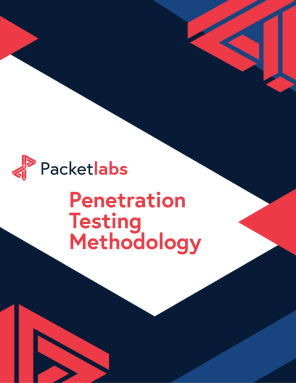Thick Client Penetration Testing: A Complete Guide
- A
- A History of Thick Clients in Cybersecurity
- Common Thick Client Architectures and Why They Matter
- The Problem with Thick Client Applications
- The Impact of Thick Client Penetration Testing
- 1. Find Vulnerabilities Before Threat Actors Do
- 2. Prove Your Security Works
- 3. Protect Sensitive Data
- 4. Strengthen Authentication and Access Controls
- 5. Reduce Business Risk and Costly Surprises
- Packetlabs' Thick Client Penetration Testing Methodology
- Conclusion
Would you like to learn more?
Download our Pentest Sourcing Guide to learn everything you need to know to successfully plan, scope, and execute your penetration testing projects.
You work hard to protect your organization. But there’s a hidden blind spot most security programs miss: thick client applications. Unlike thin clients that run in the browser, thick clients are installed directly on desktops and laptops, storing data locally and often running critical business logic. That means threat actors see them as open doors to sensitive information, customer trust, and even regulatory compliance.
The problem? Traditional testing tools only scratch the surface. Automated scans can’t fully uncover how these apps handle local storage, memory, and custom protocols. And if vulnerabilities slip through, attackers can exploit them long before you know they’re there.
At Packetlabs, we guide security teams like yours through this challenge. In this blog, you’ll discover:
The difference between thick and thin client apps (and why thick clients pose unique risks.)
The history of thick clients and why they remain relevant in today’s enterprise environment.
Common architectures, from standalone to three-tier to SOA, and what each means for your testing approach.
The top vulnerabilities we see during thick client pentests, from hardcoded credentials to weak encryption and poor session management.
A step-by-step methodology and best practices for penetration testing thick client applications.
When you understand how to test thick client applications properly, you’re no longer reactive; you’re proactive. You’ll catch flaws before threat actors do, strengthen your security posture, and demonstrate to leadership, regulators, and customers that you take protection seriously.
This guide is designed to give you clarity, confidence, and a proven path forward.
Let’s dive in:
A Thick Client Application: The Definition
Think of a thick client as a fully equipped workstation on your desktop or laptop. Instead of relying on the server to do all the work, a thick client processes much of the logic locally. That means it’s faster, more feature-rich, and capable of running offline.
Examples you use every day include:
Computer games
Web browsers
Music players
Collaboration tools like Zoom, Slack, and Teams
A History of Thick Clients in Cybersecurity
When personal computers first became mainstream, thin-client architectures took center stage. They were cheaper, lighter, and easier to maintain than outfitting every user with large, expensive terminals. For many organizations, thin clients felt like the obvious choice.
But as businesses demanded more power, responsiveness, and independence from constant server connections, thick clients emerged as the hero. Unlike thin clients, thick clients could run faster, handle heavy workloads locally, and keep working even when the network went down.
Today, they’re everywhere. From finance tools and enterprise software to communication platforms like Zoom, Slack, and Teams, thick client applications quietly drive productivity across industries. Thin clients still exist, but thick clients dominate because of their resilience and performance.
Common Thick Client Architectures and Why They Matter
Not all thick clients are built the same. The architecture of an application determines not just how it works, but also how it can be attacked (and, in turn, how it must be tested.)
Standalone: Everything runs locally, with no server and no internet connection required. Think calculators or image editors. Security testing here focuses on local file and memory analysis.
Two-tier: The client talks directly to a local or internal server/database. Security testing often looks for weaknesses in direct server communications.
Three-tier: Logic is split—your desktop client, an application server, and a database. Testing must account for HTTP/S traffic, FTP, TCP, or UDP connections.
Service-Oriented Architecture (SOA): Modern thick clients often call APIs or microservices, making them modular and scalable. Testing here digs into protocol analysis, API security, and microservice interactions.
Each structure opens a different door for attackers. Standalone apps demand deep analysis of local storage and memory. Three-tier and SOA setups shift the focus to network protocols, API validation, and data integrity.
For security professionals, understanding these architectures is step one. Without that knowledge, penetration testing risks being incomplete...and leaving your organization exposed.
The Problem with Thick Client Applications
Thick client applications are powerful, but that power comes with risk. Because they run directly on a user’s machine, they process data locally, often store sensitive information in plain view, and communicate over complex, sometimes proprietary, protocols.
They are a common attack vector due to how:
They can reverse-engineer the code to discover hidden logic.
They can tamper with locally stored data or session tokens.
They can exploit weak APIs, poor encryption, and unvalidated inputs.
In addition to their commonality, these vulnerabilities often go unnoticed until it’s too late.
If you’re a security leader, you already know what’s at stake. A single flaw in a thick client app can lead to customer data loss, regulatory fines, or business downtime.
The Impact of Thick Client Penetration Testing
If you don’t address thick client vulnerabilities:
Customer trust will erode. Nobody forgets a breach that exposed their personal data.
Downtime will cost millions. Attacks that compromise client software disrupt workflows, operations, and revenue.
Compliance could slip away. Regulations like PCI DSS, GDPR, and SOC 2 demand proactive security testing.
Attackers will get there first. Every day without testing is a day where adversaries can find and exploit what you’ve missed.
But it doesn’t have to be this way.
When you rely on thick client applications to run your business, you’re also inheriting their hidden risks. Left untested, those risks can turn into breaches, downtime, or lost customer trust.
Here’s how penetration testing changes the story:
1. Find Vulnerabilities Before Threat Actors Do
The problem: Insecure coding practices, poor input validation, and weak encryption give attackers easy openings.
The plan: Penetration testing uncovers these flaws early.
The success: You fix issues before they’re exploited, thereby closing doors on attackers and keeping control.
2. Prove Your Security Works
The problem: You think your security controls are strong, but without testing, you’re only guessing.
The plan: Simulated real-world attacks validate whether your defenses hold up.
The success: You move forward with confidence, knowing your safeguards can withstand actual threats.
3. Protect Sensitive Data
The problem: Thick clients often store customer data, credentials, and session info locally—making them prime targets and a leading cause of breaches.
The plan: Penetration testing checks if data is encrypted, secured, and shielded from unauthorized access.
The success: Privacy is preserved, compliance boxes are ticked, and your customers stay protected.
4. Strengthen Authentication and Access Controls
The problem: Weak authentication or broken role-based access means attackers can slip in or escalate privileges.
The plan: Testing exposes where these safeguards fail.
The success: Only the right people get the right access, and your users stay secure.
5. Reduce Business Risk and Costly Surprises
The problem: A single exploit can lead to lost revenue, shaken confidence, and expensive remediation.
The plan: Proactive penetration testing helps you resolve risks before attackers capitalize.
The success: Your brand reputation stays intact, your customers keep trusting you, and your business avoids the high cost of incident response.
Packetlabs' Thick Client Penetration Testing Methodology
At Packetlabs, we give you a clear path to secure your thick client applications.
Our penetration testing approach goes far beyond automated scans, encompassing:
Understand the architecture. Whether standalone, two-tier, or service-oriented, we map how your app stores, processes, and transmits data.
Test the data paths. We identify how sensitive information is stored locally and transmitted to servers, ensuring encryption and proper protections are in place.
Probe the code and logic. Through reverse engineering, code analysis, and creative exploitation, we uncover flaws scanners miss, like hardcoded credentials or poor session handling.
Evaluate APIs and communication. We test how your thick client interacts with backend services, validating authentication, input handling, and data integrity.
Simulate real attacks. Using manual exploitation techniques, fault injection, and chained attack scenarios, we demonstrate what a real adversary could do.
Deliver clarity. Our reports don’t just list issues—they give you prioritized, fix-ready guidance your engineers can act on immediately.
Conclusion
When you test and secure your thick client applications, the change is clear:
Vulnerabilities are eliminated before attackers exploit them.
Compliance gaps are closed, audits are smoother, and regulators see proof of due diligence.
Your customers feel safe, trust your brand, and stay loyal.
Leadership has assurance that the investment in security delivers measurable business value.
Instead of hoping your thick client applications are secure, you’ll know they are.
Get started with Thick Client Penetration Testing today.
Contact Us
Speak with an Account Executive
Interested in Pentesting?

Penetration Testing Methodology
Our Penetration Security Testing methodology is derived from the SANS Pentest Methodology, the MITRE ATT&CK framework, and the NIST SP800-115 to uncover security gaps.
Download Methodology
Pentest Sourcing Guide
Download our Pentest Sourcing Guide to learn everything you need to know to successfully plan, scope, and execute your penetration testing projects.
Download Guide










